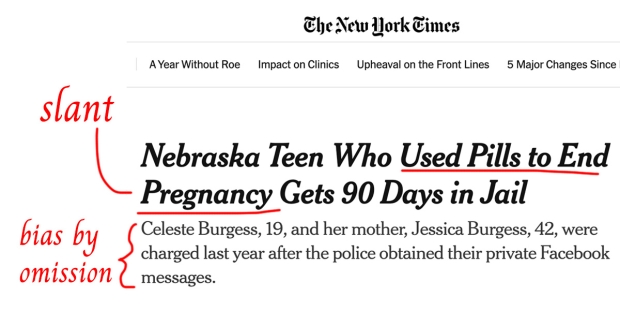Media Bias Alert: Slanted Reports on Nebraska Teen Jailed for Burning Remains After Abortion

The New York Times (Lean Left) and many other media outlets showed numerous types of media bias when reporting on a Nebraska teen jailed for illegally concealing human remains after a self-induced abortion, including bias by slant, bias by omission, and bias by viewpoint placement.
In their headlines, numerous media outlets obscured the fact that the teen was jailed for illegally concealing human remains, not for having an abortion. They showed slant and bias by omission, which made it appear the teen was jailed for having an abortion.
The New York Times’ headline, “Nebraska Teen Who Used Pills to End Pregnancy Gets 90 Days in Jail,” is slanted, making it appear that the teen was jailed for ending her pregnancy under a Nebraska law that banned abortion after 20 weeks (the law now bans abortion after 12 weeks, following the overturning of Roe v. Wade). However, the headline omits that the teen was jailed for illegally concealing human remains, implying she was jailed for using pills to end her pregnancy. It is not until deep into the article, paragraph 16, that the Times clarifies, “Prosecutors did not charge Celeste Burgess under Nebraska’s abortion law,” showing some bias by placement. The New York Times, to its credit, does reveal the true cause of her conviction in the very first, or lede, paragraph.
Slant is a type of media bias in which the media plays up a particular piece of information, or plays down another piece of information. Slant is very common in politically charged stories and can tip us off to a reporter’s bias.
The New York Times was not the only media outlet with a slanted headline obscuring the true reason the teen was jailed — many media outlets took the exact same approach:
Since the overturning of Roe v. Wade led to the implementation of stricter abortion laws in some states, many pro-choice advocates have been concerned that women will be jailed for having abortions.
Interestingly, The New York Post, a Lean Right outlet, also ran a biased headline in the same vein as Lean Left outlets: Nebraska teen Celeste Burgess gets 90 days behind bars for late-term abortion. It leads one to question - is the real culprit in these biased headlines political motivation, clickbait, or perhaps both?
On the flip side, not all media outlets obscured the truth. Some, such as Axios (Lean Left), issued unbiased headlines. Axios (Lean Left) wrote: Nebraska teen receives 90 days in jail for burning fetus after abortion.
Others unbiased headlines that give a clearer view of what happened include:
AL.com’s (Unrated) headline is slightly unclear: Nebraska teen sent to jail for having abortion, burning fetus with mother's help. The headline still could imply that the teen went to jail for having an abortion.
Digging deeper, we can spot slant and bias by viewpoint and bias by placement in the New York Times article.
The Times’ subheading gives no information as to the actual reason behind the teen’s jailing, reading, “Celeste Burgess, 19, and her mother, Jessica Burgess, 42, were charged last year after the police obtained their private Facebook messages.” Readers who take in only the headline and sub-headline would likely think that a teen was jailed for ending her pregnancy with pills, and that this information was obtained when police sorted through her Facebook messages.
Paragraph 16 states, “She pleaded guilty in May to removing or concealing human skeletal remains, a felony. Prosecutors agreed to drop two misdemeanor charges against her: concealing a death and false reporting.”
The article also shows bias by viewpoint placement — instead of quoting the prosecutor or someone else involved in the case first, The New York Times quotes an associate professor of law at the University Pittsburgh School of Law in paragraph eight. They say the case is a “harbinger of things to come” and that “this case is really sad because people resort to things like this when they’re really desperate, and the thing that makes people really desperate is abortion bans.”
It is not until paragraph 20 that we read that the prosecutor in the case “noted that the case had not begun as an investigation into an illegal abortion.” Journalistic standards dictate inverted pyramid style writing, in which the most relevant information is included first. By quoting a professor who is unrelated to the case before quoting the prosecutor, The New York Times shows bias by viewpoint.
The reporter quotes two people who are against stricter abortion laws (someone from If/When/How, an abortion rights group, and the Pitt professor), and only one person who is in favor (the executive director of Nebraska Right to Life, who did not result in a request for comment; the reporter includes a past quote from the source), showing slightly imbalanced viewpoints.
The slanted headlines raise the question of whether media bias can actually be raised to the level of misinformation. If people come away from the slanted headlines believing that a teen was jailed for having an abortion, perhaps media bias actually fuels the spread of falsehoods by twisting and misrepresenting information.
Julie Mastrine is the Director of Marketing and Media Bias Ratings at AllSides. She has a Lean Right bias.
This piece was reviewed by Joseph Ratliff, Daily News Editor (Lean Left bias).

April 29th, 2024

April 29th, 2024

April 26th, 2024

April 25th, 2024